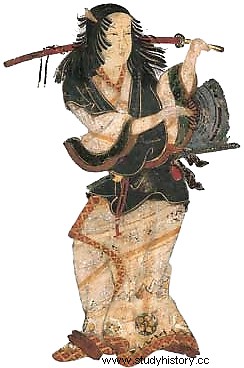Japanese artist, Izumo no Okuni (出雲阿国, around 1572 – 1613?) is considered the creator of kabuki, an epic and spectacular genre of traditional Japanese theatre.
Miko
 Many sources from his time and later, including paintings, drawings, diaries of members of the nobility , mention Okuni and teach us about its existence, but few elements are known with certainty.
Many sources from his time and later, including paintings, drawings, diaries of members of the nobility , mention Okuni and teach us about its existence, but few elements are known with certainty.
Born around 1572, during a period of unification of the Japanese archipelago, Okuni would be the daughter of Nakamura Sanemon, a blacksmith in the city of Mastue in western Japan. Like other members of her family, she may serve in the Izumo Shrine, dedicated to the kami Ōkuninushi-no-mikoto:a single source makes her a miko, a priestess in the service of the temple.
Sensual dancer
While still young, Okuni was sent to Kyoto to perform sacred dances and songs to raise funds for the temple. Afterwards, she is called back to Izumo but refuses to return, only sending money.
At first, Okuni performs traditional dances and songs. Subsequently, she was noted for her interpretation of the nembutsu odori , originally a religious dance from Buddhism but which at that time became a traditional dance. Her performance attracted attention in particular for its sensuality, and met with great success.
Kabuki-mono
In 1603, at the Tenman-gu temple in Kyoto, Okuni gave a performance where she performed in kabuki-mono (marginal and idle, especially groups of ronins) flirting with a tea house waitress. The show includes theater and dance scenes and breaks free from traditional codes. Far removed from nô theatre, the performance met with success.
At the same time, Okuni founded a theater on the banks of the Kamo River, in which she put on shows by setting up a makeshift stage when the bed was dry. For her troupe, she recruits dancers, especially excluded, marginalized, prostitutes. For their origins, their eccentricities, their freedom of tone, some call them kabuki-mono.
Gender Spread
Okuni's company enjoys the patronage of nobles, but it is primarily aimed at ordinary people and draws inspiration from everyday life. The pieces that the artists of the troupe interpret are sometimes considered cacophonous, but lively, beautiful and colorful. They spread throughout Japan, particularly through brothels, under the name of a new genre:Okuni kabuki. Or in the case of Okuni's troupe, onna kabuki (performed by women). The dancers perform female or male roles.
Sources mention Okuni's last performance in 1607 or 1612; one source indicates that she died in 1613, another mentions the less credible date of 1658. She is presumably already dead in 1629, when Shogun Tokugawa Ieyasu forbade women to participate in kabuki performances, due to the involvement of the world of prostitution in this genre. The ban will last until the end of the 19 th century.
